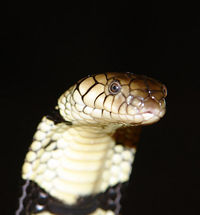Banded water cobra
| Banded water cobra | ||||||||||||||||||||
|---|---|---|---|---|---|---|---|---|---|---|---|---|---|---|---|---|---|---|---|---|
 Banded water cobra
| ||||||||||||||||||||
| Scientific classification | ||||||||||||||||||||
| ||||||||||||||||||||
| Binomial name | ||||||||||||||||||||
| Naja annulata Peters, 1876[1] | ||||||||||||||||||||
| Synonyms | ||||||||||||||||||||
|
The Banded water cobra (Naja annulata), also commonly known as the Ringed water cobra is a species of venomous snake belonging to the Elapidae family and is native to sub-Saharan Africa. This species was formerly under the genus Boulengerina, but more recent research by Wallach et al has shown that Boulengerina is actually a subgenera and Boulengerina annulata is a synonym of Naja annulata.[2] This species has two subspecies, Naja annulata stormsi and the nominate subspecies, Naja annulata annulata which is described in this article.
Etymology
The banded water cobra was described by German naturalist Wilhelm Peters in 1876. The generic name naja is a Latinisation of the Sanskrit word nāgá (नाग) meaning "cobra". The specific epithet comes from the diminutive form (“annul-") of Latin meaning anus = ring.[3]
Description
It is a large, heavy bodied snake with a short, broad and flat with an indistinct canthus and distinct from the neck. It has a medium sized dark eye with a round pupil. The body is cylindrical, the tail is long. The scales are smooth and glossy, in 21-23 rows at midbody. Adults grow to an average of 1.4 m (4.59 ft) to 2.2 m (7.22 ft) in length, but they can grow to a maximum of 2.7 m (8.86 ft).[4] Scales are smooth, indicating the largely aquatic life of this species. This species is capable of spreading a narrow, yet impressive hood. Body colors are mostly glossy brown, grayish brown, or reddish brown with black bands all along the body. The belly is pale yellow, while the tail is wholly black.[5][6]
Distribution and habitat
This species of snake is found in parts of central and western Africa. Its occurs in Cameroon, Central African Republic, Democratic Republic of Congo, Republic of Congo, Equatorial Guinea, Gabon, Rwanda, and the province of Cabinda in Angola. It is largely an aquatic species and rarely found far away from water. It can be found along lakes and rivers in forest and well wooded savanna terrain where their is sufficient cover.[5] Most common along lowland forested, bushy or wooded banks of lakes, rivers, and streams.[6]
Behavior and diet
It is a secretive species and is seldom encountered by humans. This species of snake is active by day and night, though it is usually more active by day. It is largely an aquatic snake which spends most of its time in the water. It is an excellent swimmer and is capable of remaining under water for up to ten minutes and diving to depths of 25 m (82.02 ft). It is a slow mover on land and it tends to hide amongst rocks, in holes or over-hanging tree roots at the shore line. Also makes use of any man-made structures such as bridges and jetties to hide. It is a generally non-aggressive snake. If approached in water it will swim away swiftly and on land will attempt to escape into water. If threatened on land it will rear up and spread its narrow, yet prominent hood and it may hiss loudly, but it tends not to make any forward movements. It will only bite when provoked.[5][4]
It preys almost exclusively on fish and probably eels.[5] It may also prey on frogs, toads, and other amphibians.[6]
Venom
The venom of this species is not well studied, but it is believed that the venom is dangerously neurotoxic, like that of most elapidae. A study listed the intraperitoneal (IP) LD50 of this species at 0.143 mg/kg.[7] Brown (1973) listed the IV {{LD50 at 0.2 mg/kg.[8] Subcutaneous LD50 values tend to be less toxic than both intraperitoneal and intravenous injection median lethal dose values almost all of the time, so it's safe to assume that the SC LD50 value for this species is less toxic than its intraperitoneal and intravenous values.[8][9]
Taxonomy
| Subspecies | Taxon author | Common name | Geographic range |
|---|---|---|---|
| N. a. annulata | (Buchholz Peters, 1876)[1] | Banded water cobra, Ringed water cobra | Cameroon, Central African Republic, Democratic Republic of Congo, Republic of Congo, Equatorial Guinea, Gabon, Rwanda, Cabinda |
| N. a. stormsi | (Dollo, 1886)[1] | Storms water cobra | Burundi, Tanzania |
Cited references
- ↑ 1.0 1.1 1.2 Naja annulata PETERS, 1876 at The Reptile Database. Accessed 12 May 2012.
- ↑ Wallach, V.; Wüster, W. & Broadley, D.G. (2009). In praise of subgenera: taxonomic status of cobras of the genus Naja Laurenti (Serpentes: Elapidae) at Zootaxa. Magnolia Press. Zootaxa 2236: 26–36 pp. ISSN 1175-5334
- ↑ Etymology of the word Annulata at The Reptile Database. Accessed 12 May 2012.
- ↑ 4.0 4.1 Spawls, Stephen (1995). Dangerous Snakes of Africa. London, UK: Blandford Press, 55–56. ISBN 0-7137-2394-7.
- ↑ 5.0 5.1 5.2 5.3 Boulengerina annulata - General Details, Taxonomy and Biology, Venom, Clinical Effects, Treatment, First Aid, Antivenoms. Clinical Toxinology Resource. University of Adelaide. Retrieved on 12 May 2012.
- ↑ 6.0 6.1 6.2 Boulengerina annulata. Armed Forces Pest Management Board. United States Department of Defense. Retrieved on 12 May 2012.
- ↑ Weinstein, Scott A.; James J. Schmidt, Leonard A. Smith (30). "Lethal toxins and cross-neutralization of venoms from the African water cobras, Boulengerina annulata annulata and Boulengerina christyi". Toxicon 29 (11): 1315–1327. PMID 1814007. Retrieved on 12 May 2012.
- ↑ 8.0 8.1 Brown, John H. (1973). Toxicology and Pharmacology of Venoms from Poisonous Snakes. Springfield, IL USA: Charles C Thomas, 80. ISBN 0-398-02808-7.
- ↑ Fry, Dr. Bryan Grieg. LD50 Menu. Australian Venom Research Unit. University of Queensland. Retrieved on 12 May 2012.